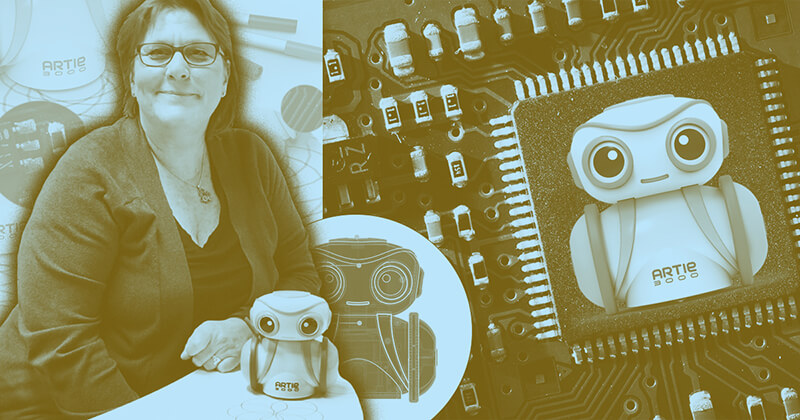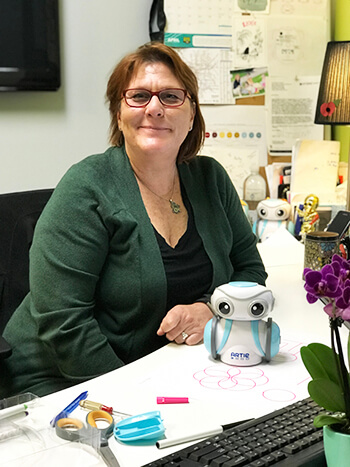This Robot Designer Blends Coding with Creativity
From robot guts to JavaScript, Mensan Kelly Recinos shares how Artie 3000™, a creative coding robot, came to be

Like many Mensans, Kelly Recinos enjoys a good challenge. When she received a phone call from Educational Insights, a company of play enthusiasts and toymakers, she was ready for a new test: to help manage the design and development of Artie 3000, a creative coding robot for kids.
But she was new to the several coding languages Artie uses, so she started by focusing on which aspects of the project should be the most user-friendly for kids and for those discovering coding for the first time. One particularly unique aspect of Artie is its ability to draw designs with a felt-tip marker using code — rare among most coding robots designed for kids.
“I like having something in my hands when I’m done,” Kelly said. “I’m a gold star kind of girl. I want to see the memory.” An avid, do-it-yourselfer, she enrolled in several online coding courses to bridge her own skills gap, and she hopes that Artie will break down barriers for young girls who are interested in learning how to code and for minority students in schools where digital literacy is sometimes lacking.
We had the opportunity speak with Kelly about why Artie was her dream project, some of the challenges she faced while managing the coding bot’s development, and her hopes for Artie — both for students who might use the technology and for educators across the country.
Laurel Gregory: When did you first hear about Mensa?
Kelly Recinos: I don’t remember if we talked about it in school, but I always thought it was really cool with the puzzle page that they had. I bet I was like 12. Is that possible? Has it been around for 30 years? If not, I was in my early teens.
How long have you been a member?
Oh, not even a year yet. I tried to do it three or four years ago, and I couldn’t finish everything. When we first started talking about Artie, I was like, “Well that’s it. I need to at least be official.” I want to get involved locally. I have a lot of friends who could do it, and I really want to get them involved as well. Growing up, you’re kind of with the same group of kids, and if you’re in any sort of educational program, I feel like it would be fun to be associated with those people and people like us.

You live in Long Beach, Calif. Are you from that area originally?
I’m from New York originally, but I grew up in Long Beach. I was in the magnet program here. I think that was pivotal in my life, because I was with a group kids throughout the city. We were all bused to one school from seventh grade through high school. In Long Beach, I was really lucky to have this program, and then also this incredible diversity. There’s every kind of demographic you could think of — race, ethnicity, socioeconomic status. We’re just all this big soup, and it’s awesome. It’s kind of like these are the kids I want to join Mensa with me — just the amazing way people view things, the different ways people solve issues or problems, the learning disabilities that we all struggled with, how we did it together — it was an amazing experience. That’s why I looked to Mensa, because I knew that these were my people.
Tell me about your involvement in the process of creating a coding robot for kids.
I have worked with Educational Insights a couple times in my life. EI had started Artie before I got there. I manage stress well, so when Artie came up, it was a project that they wanted to get to market in a certain time period. A couple of project managers had worked on it, and they called me and said, “We need somebody to come in and take this over, and by the way, can you do it in six months?” They had done the sculpt of what he looks like — how his body looks. They had done some color decisions, and then they had these guts that had been a Kickstarter in England for five years. Essentially, what Artie does was already existing. I just had to make it kid-friendly and not foolproof but more stable.
It was so fast I don’t know how to describe it. He seemed to come out of all the parts himself. We wanted this in the hands of 7-year-olds. I went through and saw the sculpt they had done. We managed to get this well-thought-out engine inside the body that was already created. Then we had to refine things such as what functions do we want for this age group, and how do we get kids involved right out of the box? How do we pull them in? We had to get Artie’s personality not looking like multiple personalities. It was exciting.
That’s interesting. I didn’t know the backstory and that the inner workings were already created.
Yeah, it was a huge help too. I also had to learn a lot of coding in areas I hadn’t worked with before. I had done things like, I have an existing engine, I need it to pull up these assets and do this with them. It’s in JavaScript, JS, and all these things I don’t completely understand yet. I’m taking an online class now because it’s interesting. It’s just one of those things where it’s like problem solving. These huge, insurmountable mountains rise before you and you’re like, “OK, if I just chip away here, I’ll know which way to go.”
How do you make a toy educational, something that a child can learn from?
I’m a big fan of multiple levels of access in any kind of toy. Are you going to play with it this way? Are you going to play with it that way? Are you just going to hold it? Because we had 7-year-olds, we knew that a lot of them will be excellent readers, and some will be early readers. We really tried to make it very simple with the interface. You can turn, and it uses the 360 degrees. You even can specify how many degrees you want to turn. That’s a little bit of geometry they have to learn. Then as far as coding goes, we introduced loops, pen up, and pen down. There are very few commands. Once you get those four down, you can draw a lot of stuff.
I think the way to get younger women involved is to make a safe space for them — more of a brave space. It’s OK to fail. Failing is how you do computer programming.
How do you think that we can get more young girls to be interested in learning how to code? And do you see Artie playing a role?
I think that it’s just making sure that everybody is welcomed. I worked in a group called Chicks Can Code, and we were going over HTML through Code Academy. It was just women who were taking the class. It’s so much easier when you’re in a group taking it together and you can say, “Did you figure out how to do this?” I think the way to get younger women involved is to make a safe space for them — more of a brave space. It’s OK to fail. Failing is how you do computer programming. Essentially, you try something, it doesn’t work, and you try it a different way.
Having a robot that has something existing that you can look at, and then manipulate, and solve that way, it doesn’t make it feel like failing. It’s like experimentation. I always like having something to walk away with. I like having something in my hands when I’m done.
Because Artie blends coding with creativity, can you tell me about how your team decided to make Artie a creative coding robot?
Well, the nice thing about EI is, it’s essentially right brain and left brain. We’ve got the educational mission, but then we’re also a bunch of creative people in one room together. Having these people who have a mix of experience is great at EI. You’ve got the creatives that say, “Well, I really excelled in school when I was able to make magazines for our favorite book report or when we did masks of our tribe we studied in Africa.” It was that kind of experience that everybody remembered. Having something that combined art and coding — the coding parts some people got and the art parts some people got — made the other side more accessible.
Because Artie’s a toy that’s meant for children, how was your team able to ensure that Artie was easy to use right out of the box and something that parents could get involved with too?
That was important because we want our toys to be successful. We want our students, the kids who get to play with them, to feel what we feel when we have a project that’s really exciting. The problem with coding in lots of spaces is that there’s so much parent involvement, and it’s really intimidating, so we created these pre-programmed projects: the circle, the square, the triangle. You can open him up and we have a quick start guide and you jump right in. There are also a lot of kids who are obviously more digitally literate than their parents are, so we want them to be able to explore on their own, not to go, “I want to do this experiment next. Can you help me?” It’s tangible progress that you can walk into the room and hang on the fridge. Hopefully, the parents will just pass by the kid’s experiments.
Do you think that Artie can also serve as a tool for students and educators inside the classroom to break down some of the barriers that minority students face when it comes to digital literacy?
I absolutely hope so. The nice thing that we got excited about with Artie was that we were able to bring him in at a price point that could possibly support multiple Arties in a class and with multiple language guides, but I’m hoping that libraries really like him. There’s a whole level of innovation that we’re missing by not having tools like Artie available for people with different backgrounds. I come from a diverse city. I can’t wait to see what people do differently with Artie.
There are so many things that can be done, and honestly, I’ve been working so hard to get him available, I haven’t had time to even explore his possibilities. That’s the exciting part. As my old boss used to say, “This is where the rubber hits the road.” Literally.
